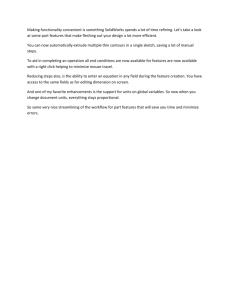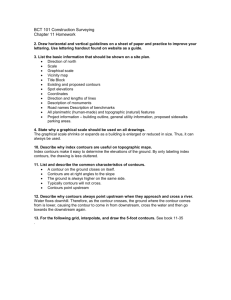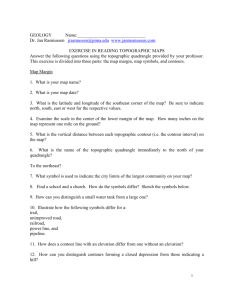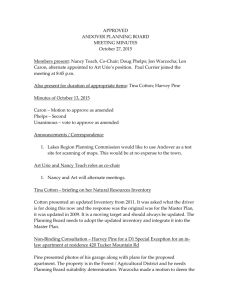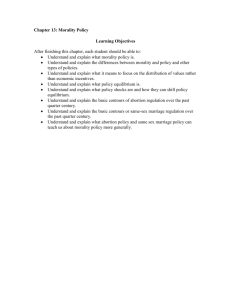Is there Traditional Contours for Patentable Subject Matter?: The Intersection of Golan v. Holder and Mayo v. Prometheus
advertisement
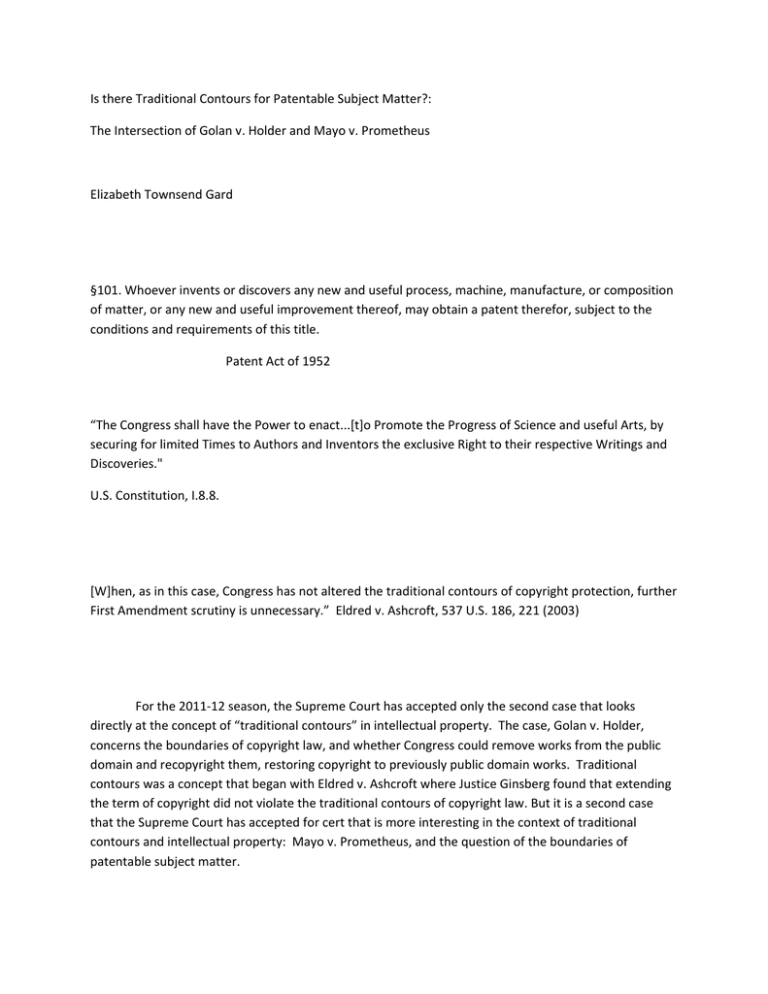
Is there Traditional Contours for Patentable Subject Matter?: The Intersection of Golan v. Holder and Mayo v. Prometheus Elizabeth Townsend Gard §101. Whoever invents or discovers any new and useful process, machine, manufacture, or composition of matter, or any new and useful improvement thereof, may obtain a patent therefor, subject to the conditions and requirements of this title. Patent Act of 1952 “The Congress shall have the Power to enact...[t]o Promote the Progress of Science and useful Arts, by securing for limited Times to Authors and Inventors the exclusive Right to their respective Writings and Discoveries." U.S. Constitution, I.8.8. [W]hen, as in this case, Congress has not altered the traditional contours of copyright protection, further First Amendment scrutiny is unnecessary.” Eldred v. Ashcroft, 537 U.S. 186, 221 (2003) For the 2011‐12 season, the Supreme Court has accepted only the second case that looks directly at the concept of “traditional contours” in intellectual property. The case, Golan v. Holder, concerns the boundaries of copyright law, and whether Congress could remove works from the public domain and recopyright them, restoring copyright to previously public domain works. Traditional contours was a concept that began with Eldred v. Ashcroft where Justice Ginsberg found that extending the term of copyright did not violate the traditional contours of copyright law. But it is a second case that the Supreme Court has accepted for cert that is more interesting in the context of traditional contours and intellectual property: Mayo v. Prometheus, and the question of the boundaries of patentable subject matter. The question in Mayo v. Prometheus centers around the patenting of a diagnostic test. The Petitioners are arguing that the results are merely a correlation between a naturally occurring process in the body and a doctor’s knowledge of what that result means. To patent this, according to the Petitioners, would be to contravene long establishsed notions abstract ideas do not qualify for patentable subject matter. They argue that the patenting of such a test actually creates a First Amendment violation, as it restricts a doctor’s “freedom to think.” One amicus brief quickly made the connection. If there is a First Amendment violation within an intellectual property context, surely Eldred’s traditional contours language would come into play. This essay looks directly at that intersection: what role does traditional contours play in both copyright and patent law, particularly at this moment, when there are two cases being reviewed by the Supreme Court that assert First Amendment violations in each? This article suggests that “traditional contours” could become a powerful doctrinal tool within the theorectical arsenal of intellectual property law. While the concept began as a conclusionary sentence in Eldred, the phrase “traditional contours” may be able to provide balance, guidance, and structure to an otherwise ever changing and expanding laws of intellectual property law. When are new laws merely an expansion necessary to keep up with technology, a global economy and new ways of thinking, and when do these laws go beyond the “traditional contours” of intellectual property, potentially upsetting the balance, the physics, of the system? Copyright and patents are bound together by the IP clause: 1.8.8. Both serve the public good by granting for “limited Times” monopolies to inventors and authors. [6] For over two hundred years, a discourse filled with certain expectations has developed in both copyright and patent law. The question is what components are essential for a working system in each area, and which elements can be altered. Restoring foreign works was a dramatic moment in copyright law. Did it alter the traditional contours of copyright law? We will have to wait to see what the U.S. Supreme Court decides. But if restoring works may alter tradition, certainly the Bilski‐Prometheus line of patentable subject matter cases, along with the new America Invents Act, bring up just as many questions regarding the boundaries and requirements of the IP system. The Fall brought so many new events that all seemed to be calling for “traditional contours” analysis. Part II describes five events in particular: the America Invents Act, ACTA, Golan v. Holder, Prometheus v. Mayo, and the Sound Recording Simplification Act. Could a traditional contours test help us better evaluate new legislation, and better guide courts in dealing with global trade, new technologies, and unexpected applications? Part III looks at how “traditional contours” as a concept, test and/or doctrine has developed today. In almost a decade, traditional contours has remained fairly undefined and under‐utilized. The Golan case may change that equation. But this section looks at how it has been interpreted (or not) by courts and by scholars. Part IV begins to look to a more sophisticated way of using “traditional contours,” first by turning to the work of Gard and Townsend Gard which directly addresses the “traditional contours” language from the 10th Circuit Golan court, but also looks to others’ in the field of intellectual property that are theorizing about the foundations of IP. This heart of the paper argues that much of the work being done by Merges, Madison, and others could be put within a traditional contours framework, particularly when structured within a two‐part function and historical test and/or Merges mid‐level principles. This section argues that “traditional contours” affords greater insight into the particular issue at hand than merely a doctrinal reading. Part V then turns to patent law. How does traditional contours allow us to sort through the current struggles? In particular, the section will look at the Bilski‐Prometheus line of patentable subject matter cases, along with small sections of the America Invents Act. Part VII concludes with the question: could the concept of traditional contours be useful or viable for copyright and/or patent protection?
